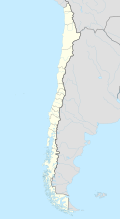Quellón
Quellón is a city in southern Chile and is located on the second largest island in the country of Chiloé in the Región de los Lagos . Quellón has around 21,000 inhabitants (2003).
geography
The port city is located in the southeast of the island of Chiloé on the Panamericana , it is its official end point.
The climate is mild, but extremely humid.
history
In 1743 the parts of the Caucahues indigenous were resettled on the island of Cailín. The island is just south of the city of Quellón. Here the Jesuits build a church and do missionary work.
On February 25, 1881, the Chilean President gave the order to build a port in the village today known as "Quellón Viejo", which is four kilometers away. The port was built on the Punta de Lapas peninsula .
In 1905, the company Destilatorio Quellón S.A. was founded in what is now the port of Quellón , producing charcoal, acetone and alcohol in a wood distillery on a site that was called Llauquil by the locals . She founded the city of Quellón in 1906. A short, narrow-gauge railway from the port to the forest was built to transport the wood. The distillery, at that time the only one of its kind in South America, ensured an economic boom in the entire area. Wood and charcoal were shipped from Quellón to the saltpeter works in northern Chile. In 1952 the distillery was closed due to sales difficulties.
Originally, most of the city's residents lived on the coastal road, where there were numerous stilt houses ( palafitos ), but almost all of them were destroyed in the devastating earthquake and the subsequent tsunami of 1960 and were not rebuilt afterwards. After 1960, most of the residents of Quellón settled a little further inland, where new roads were built. The city was only accessible by ship until 1966, when the Panamericana to Quellón was completed. A memorial plaque in Quellón commemorates the end of the 22,000 km long Panamericana. At the beginning of the 21st century, the city experienced an economic boom as a fishing port.
economy
Quellón lives mainly from tourism, fishing and the fish processing industry. The city is one of the most important ports on Chiloe.
tourism
There are two museums worth seeing in Quellón: The Museo Inchin Cuivi Ant explains the culture of the indigenous Huilliche , while the Museo Municipal primarily presents the history of the city. The city's cultural center with exhibition and event halls was built with financial support from a salmon processing company. A lot of handicrafts are on sale at the Feria Artesanal Llauquil . Some hotels and restaurants can be found on Costanera P. Montt , which runs along the sea .
There are many small bays and beaches around the city, but the water temperature is too low for some people to swim.
The Panamericana ends in the village of Punta de Lapa , five kilometers from Quellón. The village has a five kilometer long beach. In Quellón Viejo , a village four kilometers to the southwest, which is considerably older than the city of Quellón, a wooden church from the beginning of the 20th century typical of Chiloé is worth seeing. There are wooden tombs in the cemetery. The tomb of the first clergyman in the village, Delfin Gatti, who died in 1907, is an exact replica of the village church in a reduced form.
Around Quellón there are also a number of indigenous Huilliche villages, e.g. B. Compu (approx. 25 km north) with a wooden church built at the beginning of the 20th century. Also Yaldad seven kilometers west of Quellón, with its approximately 500 inhabitants is a village of Huilliche in which a built in the early 20th century, typical of the island of Chiloé and is in 1985 and 1990 restored wooden church.
Trincao (ten kilometers) with an interesting cemetery and a church built in 1920 is one of the places worth visiting in the area around Quellón .
Transport links
From Castro, the capital of the island of Chiloé, 92 km away, Quellón can be reached several times a day by bus. From Quellón there are ferry connections to Puerto Chacabuco and Chaitén .
Image gallery
See also
Individual evidence
- ↑ Juan Mancilla Pérez: Pueblos de Chiloé. P. 66. Castro 2008
- ^ R. Jorge Sànchez: Chiloé - tradición y cultura. P. 44. Santiago de Chile 2006. ISBN 956-309-024-1
- ↑ Dominique Verhasselt: Chiloé archipielago - el encanto de una isla misteriosa , p. 118. Santiago de Chile undated ISBN 978-956-7136-53-7
- ↑ Jorge Sànchez R .: Chiloé - tradición y cultura , p. 45. Santiago de Chile 2006
- ↑ Juan Mancilla Pérez: Pueblos de Chiloé. P. 67. Castro 2008
- ↑ Juan Mancilla Pérez: Pueblos de Chiloé. P. 68. Castro 2008
- ↑ Juan Mancilla Pérez: Pueblos de Chiloé. P. 69. Castro 2008
Web links
Coordinates: 43 ° 6 ′ S , 73 ° 36 ′ W







